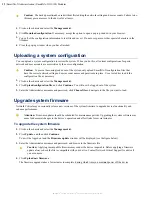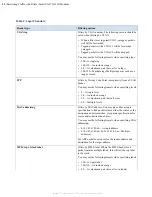
SmartNA-X 1G/10G Modular | Configuring Ports |
43
SmartNA-X
™
1G/10G User Guide 1.4
©
2015 Network Critical Solutions Limited
About TAP mode
TAP mode allows copper ports to maintain connection through a port pairing (
AB
or
CD
) in the event of a power failure.
This feature is known as "failsafe" and is available for RJ ports only, not SFP ports.
Failsafe works by continually monitoring power to the TAP ports. If power is lost, failsafe activates a relay switch
across the port pairing (
AB
and/or
CD
) to allow traffic to keep flowing. When power to the device is restored, failsafe
deactivates the relay and returns the device to managed operations once more.
There will only be a very brief interruption of traffic while the connection switches to the relay, and again when it changes
back to normal as power is restored. The port settings must be configured so the two partner ports are compatible when
connected directly to each other via the failsafe relays.
The SmartNA-X TAP modules have a feature called "fast-failsafe" that minimises the interruption to traffic when power is
restored, by reducing the probability of an auto-negotiation process. To take advantage of this feature, use LFP (not LMP),
and it is advisable to set both sides to advertise only 1G full-duplex, and to set both sides' MDI settings to non- auto (that
is, MDI or MDI-X). The partner ports must use opposite MDI settings (assuming no crossover cables are used).
LFP (Link Failure Propagation)
LFP is a TAP mode that allows link failures in a port pairing to be propagated to the partner port such that if either side
goes down the other side is also taken down.
LMP (Link Mode Propagation)
LMP is a TAP mode that can be applied to a port pair to make the presence of the TAP relatively invisible to the partner
ports.
LMP extends LFP by making each of the TAP links behave as if it were the nominal partner. Thus, if you connect
device
X
to port
A
and device
Y
to port
B
,
A
behaves as if it were
Y
and
B
as if it were
X
, making the presence of a TAP
relatively invisible to the partner ports.
LMP is a TAP mode option that can be chosen instead of LFP, giving three possibilities: None, LFP, or LMP. When LMP
is selected it has control over the speed, duplex and master/slave characteristics of the ports, and the effect of changes to
speed, duplex, and master/slave mode is postponed until LMP is switched off. Until the link is up at both ends each port
will be disabled, which prevents any traffic travelling over half of the link while the other half is down.
Note that switching LMP on will cause the ports to go down initially before establishing a link. LFP links take longer to
establish than LFP.
LMP and half-duplex mismatches
When using LMP, duplex mismatches occur when either of the link partner ports is set to non-auto half-duplex, as
follows:
•
A
=Half duplex,
B
=Auto-negotiation: There will be a duplex mismatch at
B
that would not occur with a direct
connection.
•
A
=Half duplex,
B
=Full duplex: There will be a connection at
B
without the duplex mismatch that would usually occur
(although but this may be irrelevant as there is a mismatch at
A
).
•
A
=Half duplex,
B
=Half duplex: There will be a duplex mismatch that would not occur with a direct connection.
Avoiding duplex mismatches
A duplex mismatch occurs when two connected devices operate in different duplex modes. That is, one device operates in
half-duplex mode whilst the other device operates in full-duplex mode.
A duplex mismatch is often the cause of slow and unreliable connections and may produce fragmented packets.
Duplex mismatches can occur when:
• One of the ports is set to full-duplex and the other is set to half-duplex.
• One of the ports is set to auto-negotiate and the other is set to full-duplex.
In the second scenario, the port set to auto-negotiate will connect in half-duplex mode, resulting in a duplex mismatch.
This type of behaviour is described in IEEE802.3-2008 Section 3: 37.1.4.4 and is a requirement for legacy devices that
support half-duplex mode only.
















































